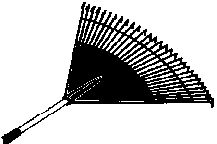![[Snakeroot Organic Farm logo]](pix/sof.gif)
At dawn
Canoe bow waves are quickly lost
on the shoreside
But go on out of sight
on the lake side.
-1986
The constant swish-swish of skis
On a day long ski.
The constant swish-swish of wiper blades
On a day long drive.
-1990
My dog, trotting barefoot
Steps on a garden slug
And thinks
Nothing of it.
-1999
Word spreads quickly
as I approach the pond.
All becomes quiet.
-1997
Hidden in the vines
a large warted cucumber
jumps out of reach.
A toad!
-1997
Delicate puffs
of marshmallow snow
carefully perched
on a branch,
await the trigger of my hat
to melt their way down my back.
-2010
Deep in the tomato jungle
Fruits of yellow, purple and red
Tell of their readiness
To go to market.
-2010
Sugarin' Chores
Snowflakes hurry through my flashlight beam,
As my boots knead new snow with spring mud,
On my nightly Hajj to keep the boil alive,
For as long as possible until the dawn,
To match the power of the flowing sap,
With my meager evaporator and will.
The prize at the finish line are jars of syrup
And Spring.
-2013
WHAT WE WANT
When? Any daylight hour. Seven days a week. All year round.
How? Just drive in and drop it off. The first time you stop by, you may be able to immediately see where to drop what. If its not obvious, beep your horn and we will show you where to put bagged items or loose items. If you put things in the wrong place, its really no big deal, since we can move them with our bucket loader. Getting stuff put where we want it just saves us a little work.
Why? When you bring your leaves to the dump (transfer station), they are either burned (adding to air pollution), or burried (taking up space in the landfill), or hauled away (adding to transfer station expenses). Instead of bringing these items to the dump, where the town has to spend our tax money to handle and dispose of them, bring them to us where we will use them on our organic farm for growing our vegetables and herbs. The Town of Pittsfield has estimated that we annually recycle 55-60 tons of organic waste materials from town residents, each year saving the town's transfer station over $3,000 in handling costs. You'll be feeding a farm that feeds your community.
What do we do with it all? We are eager to receive your organic matter for use as mulch and in our compost piles. Composts and mulches are basic ingredients in organic farming. We use pine needles, shredded leaves and mixes of shredded leaves and grass clippings as a mulch on our planting beds. Plantings where we use mulches include tomatoes, celery, garlic, asparagus, rhubarb and perennial herbs. Mulch is a layer of organic matter which is used to retain moisture in the soil, suppress weed growth, keep the beds from freezing in the winter and keep the soil cooler in the summer. During the growing season, the action of soil microbes and earthworms eventually break down the mulch and it becomes humus, adding to the fertility of our soil. Whole leaves, garden waste and grass clippings are used to build to our compost piles. These items are mixed with cow manure and hay, then piled high to heat as the microbes do their magic. The piles are turned several times during the following year. This completely remixes the ingredients, and adds air to the interior of the pile to keep the microbes active. Each time the piles are turned, the original ingredients become less and less identifiable as they decompose their way to finished compost. Eventually, in the third year, the compost piles are loaded into our manure spreader and spread onto our five acres of gardens. The compost is then disked into the soil and seeds are planted or transplants set out. Meanwhile, every year we have compost piles in the building stages and the turning stages. This is basically the same process nature uses in forests and fields; we just organize it and speed it up a bit. If you would like to know more about how we do things, or would like a tour of our compost piles or mulched beds, we would be more than glad to share with you what we are doing. More info about composting and mulching can be found at our website http://snakeroot.net/farm/UsingMulches.shtml Where are we? We are located on the Snakeroot Road in Pittsfield. You can find us by going 1/2 mile down the Snakeroot Road from the Weeks Road end. Our driveway is called Organic Farm Road and is on the right, opposite the first house on the left. If you look down our driveway, you can see our sign. At the end of our driveway is a large open gravel area with plenty of room even to turn your trailer around in and drop your load. |
 27 Organic Farm Road, Pittsfield Maine 04967 http://www.snakeroot.net/farm owned and operated by Tom Roberts & Lois Labbe Tom: Tom@snakeroot.net (cell) 207-416-5417 or Lois: Lois@snakeroot.net (cell) 207-416-5418 Gardening for the public since 1995. |
|
|


